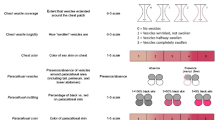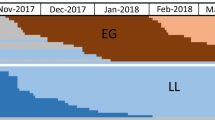Abstract
Female Japanese macaques are seasonal breeders distinguished by their red-colored hindquarters, face, and nipple skin areas. Intensity of coloration seems to be associated with sexual attractiveness, behavior, and fluctuating sex steroids. Our aim was to investigate whether the color intensity of these regions differed between lactating (LA) and non-lactating (NLA) females during sexually inactive (SI) and active (SA) phases. Coloration scores of 19 adult females were classified using color tables. Estrogen and progesterone metabolites were determined in fecal samples. Weekly comparison between both groups revealed significantly increased coloration of the hindquarters area from week 13 (SI) until the end of the observation period, and for the nipple skin throughout the SI and SA periods. Face coloration differed marginally. Hormonally, NLA females showed significantly increased excretion rates of sex steroids at the end of the SI phase and throughout the whole SA period. Logistic regression analyses between elevated fecal steroids and nipple coloration disclosed a significant relationship for NLA females during the SI period. This connection persisted and included hindquarter coloration during the SA period. NLA females showed increased intromission with ejaculation, but no difference was found for intromission without ejaculation. In conclusion, results demonstrate increased endocrine excretion rates for NLA females during the whole observation period, paralleled by an enhanced, fertility-signaling sexual attractiveness.



Similar content being viewed by others
References
Anderson CM, Bielert CF (1994) Adolescent exaggeration in female catarrhine primates. Primates 35:283–300
Bradley BJ, Mundy NI (2008) The primate palette: the evolution of primate coloration. Evol Anthropol 17:97–111
Cheng G, Li Y, Omoto Y, Wang Y, Berg T, Nord M, Vihko P, Warner M, Piao YS, Gustafsson JA (2005) Differential regulation of estrogen receptor (ER)alpha and ERbeta in primate mammary gland. J Clin Endocrinol Metab 90:435–444
Czaja JA, Robinson JA, Eisele SG, Scheffler G, Goy RW (1977) Relationship between sexual skin colour of female rhesus monkeys and midcycle plasma levels of oestradiol and progesterone. J Reprod Fertil 49:147–150
Dixson AF (1983) Observations on the evolution and behavioral significance of “sexual skin” in female primates. Adv Stud Behav 13:63–106
Domb LG, Pagel M (2001) Sexual swellings advertise female quality in wild baboons. Nature 410:204–206
Dubuc C, Brent LJN, Accamando AK, Gerald MS, MacLarnon A, Semple S, Heistermann M, Engelhardt A (2009) Sexual skin color contains information about the timing of the fertile phase in free-ranging Macaca mulatta. Int J Primatol 30:777–789
Fujita S, Sugiura H, Mitsunaga F, Shimizu K (2004) Hormone profiles and reproductive characteristics in wild female Japanese macaques (Macaca fuscata). Am J Primatol 64:367–375
Gauthier CA (1999) Reproductive parameters and paracallosal skin color changes in captive female Guinea baboons, Papio papio. Am J Primatol 47:67–74
Gerald MS, Waitt C, Little AC, Kraiselburd E (2007) Females pay attention to female secondary sexual color: an experimental study in Macaca mulatta. Int J Primatol 28:1–7
Gerald MS, Waitt C, Little A (2009) Pregnancy coloration in macaques may act as a warning signal to reduce antagonism by conspecifics. Behav Processes 80:7–11
Higham JP, MacLarnon AM, Ross C, Heistermann M, Semple S (2008) Baboon sexual swellings: information content of size and color. Horm Behav 53:452–462
Kondo M, Kishi H, Kojima C, Jin W, Suzuki J, Shimizu K, Itoh M, Ohkura S, Tsukamura H, Maeda KI, Watanabe G, Taya K (2003) Lactation-associated infertility in Japanese monkeys (Macaca fuscata) during the breeding season. Zoo Biol 22:65–76
Machatschke IH, Dittami J, Wallner B (2006) Morphometric and hormonal changes during the chimpanzee menstrual cycle. J Med Primatol 35:331–340
Maeda KI, Tsukamura H, Ohkura S, Kanaizuka T, Suzuki J (1991) Suppression of ovarian activity during the breeding season in suckling Japanese monkey (Macaca fuscata). J Reprod Fertil 92:371–375
Martin P, Bateson P (1994) Measuring behaviour. Cambridge University Press, Cambridge
Mitsunaga F, Nozaki M, Shimizu K (1994) Suppressed copulatory behavior and ovarian function in lactating Japanese monkeys (Macaca fuscata fuscata) during the mating season. Primates 35:79–88
Möhle U, Heistermann M, Dittami J, Wallner B, Hodges JK (2005) Patterns of anogenital swelling size and their endocrine correlates during ovulatory cycles and early pregnancy in free-ranging Barbary macaques (Macaca sylvanus) of Gibraltar. Am J Primatol 66:351–368
Onouchi T, Kato J (1983) Estrogen receptors and estrogen-inducible progestin receptors in the sexual skin of the monkey. J Steroid Biochem 18:145–151
Palme R, Möstl E (1993) Biotin-streptavidin enzyme immunoassay for the determination of oestrogens and androgens in boar faeces. In: Görög S (ed) Advances of steroid analysis. Akadémiai Kiadó, Budapest, pp 111–117
Schwarzenberger F, Tomasova K, Holeckova D, Matern B, Möstl E (1996) Measurement of fecal steroids in the black rhinoceros (Diceros bicornis) using group-specific enzyme immunoassays for 20-oxo-pregnanes. Zoo Biol 15:159–171
Stevens M, Stoddard MC, Higham JP (2009) Studying primate color: towards visual system-dependent methods. Int J Primatol 30:749–751
Takahata Y (1980) The reproductive biology of a free-ranging troop of Japanese monkeys. Primates 21:303–329
Waitt C, Gerald MS, Little AC, Kraiselburd E (2006) Selective attention toward female secondary sexual color in male rhesus macaques. Am J Primatol 68:738–744
Wallner B, Prossinger H, Möstl E (1999) Perineal swellings: a social and endocrine advantage for Barbary macaque females (Macaca sylvanus). Coll Antropol 23:451–459
Wallner B, Dittami J, Wallis J (2006) Influence of perineal swellings on behavior and stress reaction in levonorgestrel implanted Macaca sylvanus females. Neuro Endocrinol Lett 27:253–256
Wallner B, Mostl E, Dittami J (2007) Chronic levonorgestrel treatment in Macaca sylvanus: effects on perineal swelling size and fecal sex steroid excretion. Neuro Endocrinol Lett 28:326–332
Author information
Authors and Affiliations
Corresponding author
About this article
Cite this article
Wallner, B., Aspernig, D., Millesi, E. et al. Non-lactating versus lactating females: a comparison of sex steroids, sexual coloration, and sexual behavior in Japanese macaques. Primates 52, 69–75 (2011). https://doi.org/10.1007/s10329-010-0221-7
Received:
Accepted:
Published:
Issue Date:
DOI: https://doi.org/10.1007/s10329-010-0221-7




